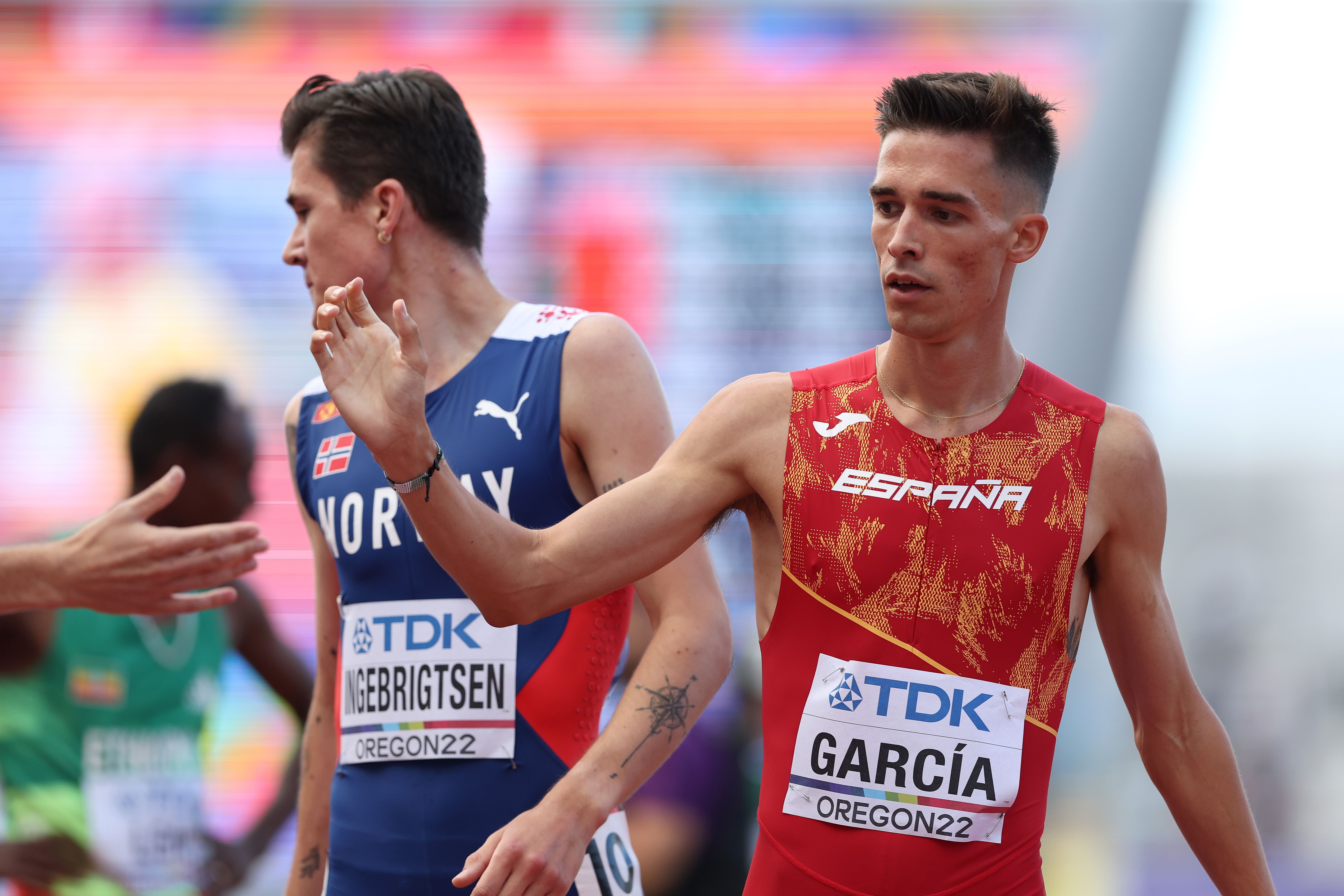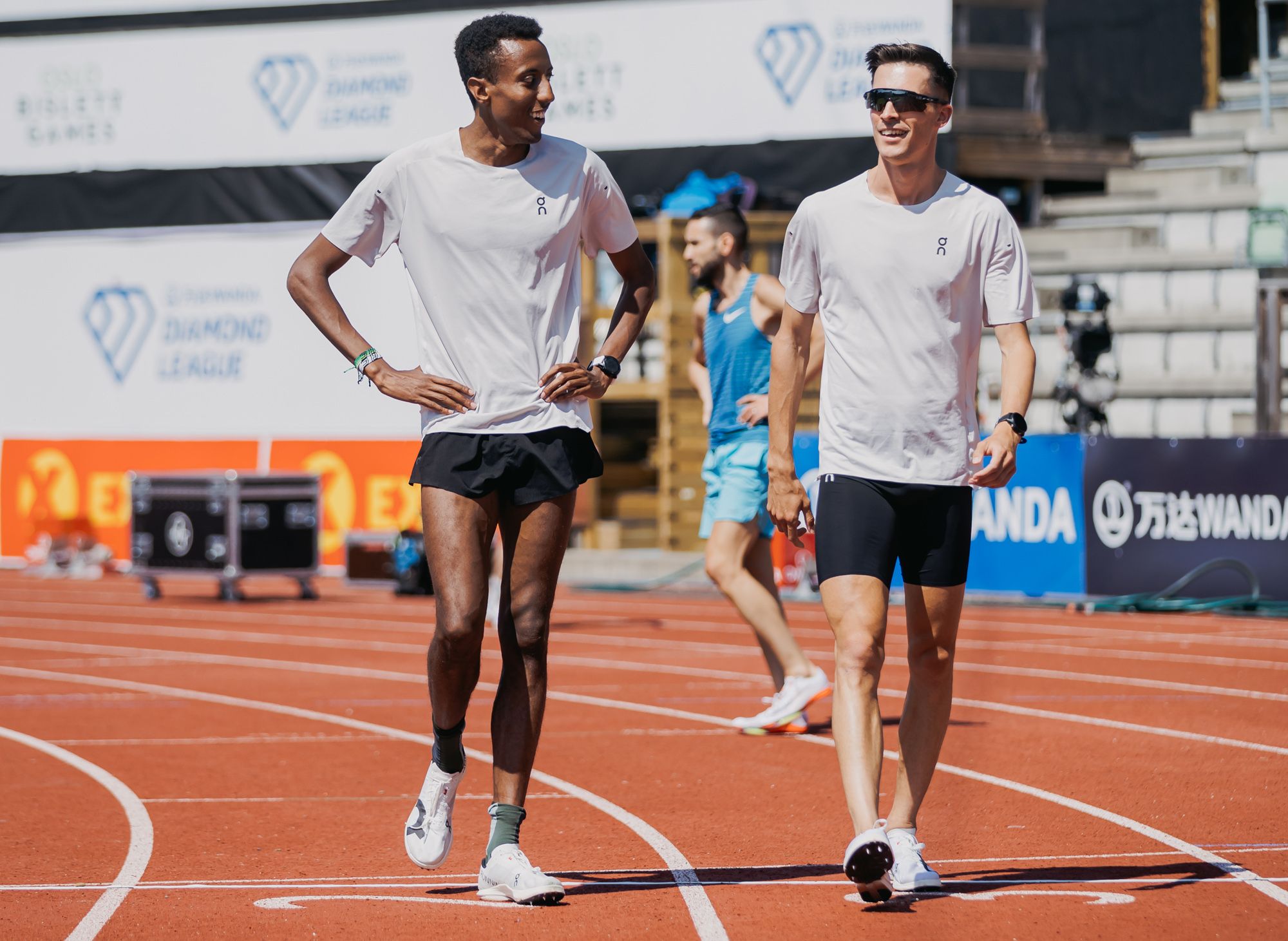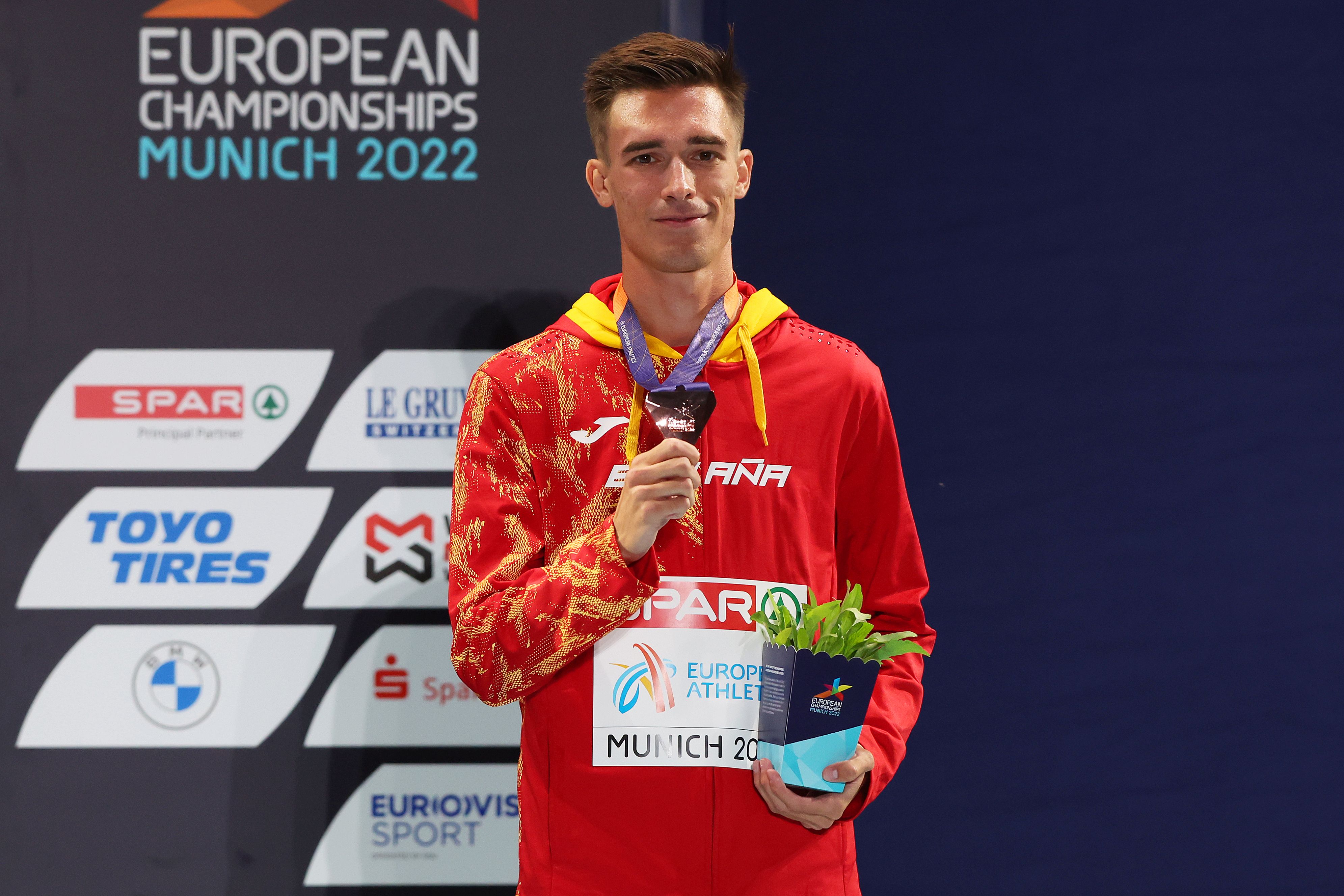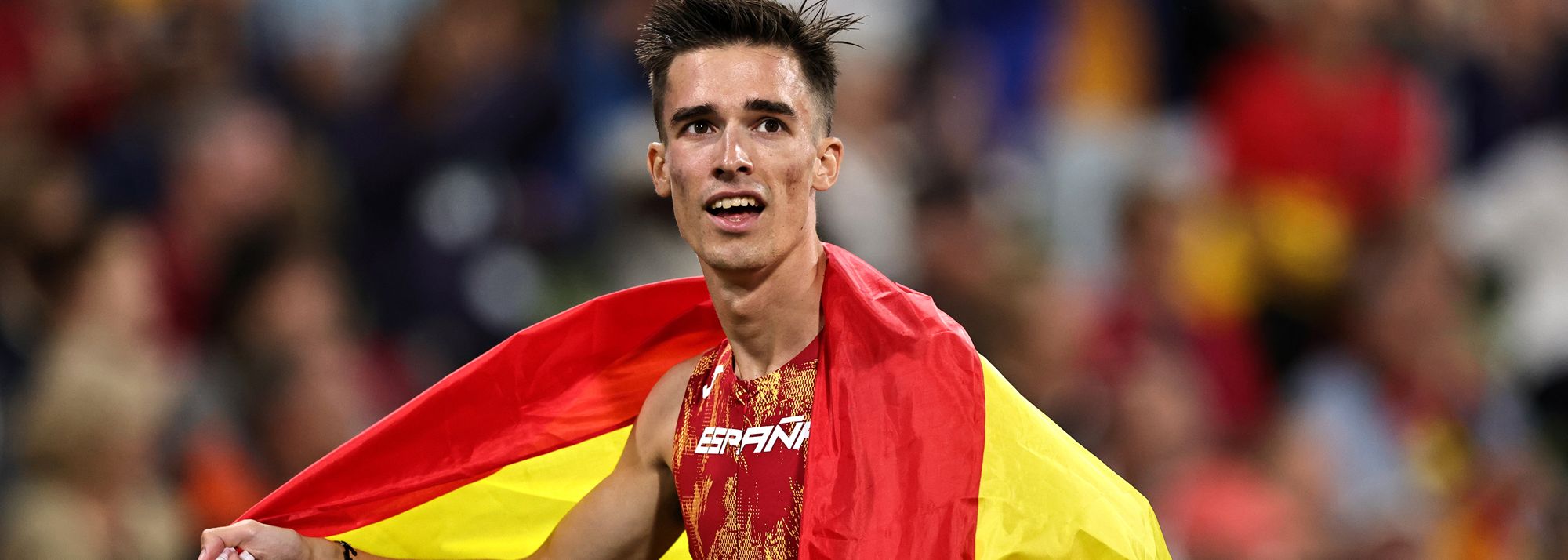Mario Garcia Romo after taking bronze at the European Championships (© Getty Images)
Mario Garcia Romo may be one of the newest members to the 1500m sub-3:30 club, but the Spaniard cares more about championship performances than fast times.
But sometimes – as was the case at last year’s World Championships – a fast time is required for a strong championship showing.
In fact, to simply secure his place on the Spanish team for the World Championships, Garcia Romo produced a lifetime best of 3:35.52 to win the national title, beating Spanish record-holder Mohamed Katir.
Garcia Romo’s momentum continued at the World Championships three weeks later as he navigated the rounds, setting a PB of 3:35.43 in his heat, finishing second in his semifinal, and then placing fourth in the final in a huge PB of 3:30.20 – just 0.30 shy of a medal.
“The World Championships final gives you extra motivation,” says Garcia Romo, who earned silver at the European U23 Championships one year prior. “It was quite a clean race (in Oregon) and I thought I would be able to dip under 3:32 that day, but clocking low 3:30 was definitely a surprise and a great joy.
“I was focusing on finishing as high as possible and not on running fast,” he added. “Actually, I never compete with the aim of running extremely fast times or breaking any record, but on just winning the race. If you win the race, you’ll most likely manage a fast time. I think that’s the right approach.”

Mario Garcia Romo at the World Athletics Championships Oregon22 (© Getty Images)
One month after the World Championships, Garcia Romo finally achieved his moment on a major championships podium when taking European bronze in Munich.
Garcia Romo was a promising U20 athlete, clocking 3:42.35 at the age of 17, but he intentionally didn’t train too hard back then.
“Of course, I trained seriously but always with room for improvement,” said Garcia Romo, who was coached by Lucio Rodriguez back then. “I would even say I’m not training at 100% right now. I believe it’s better to train not too hard and stay healthy; maybe that’s the reason I’ve only suffered one injury – a sacrum facture in 2019 – in 15 years of career.
“My motto is: OK, I’ve finished my workout, but I still could do at least one more rep.”
The American dream
In the summer of 2018 – and inspired by his older brother Jaime – Garcia Romo moved from Villar de Gallimazo, a village of barely 200 inhabitants, to Mississippi to attend the University of Mississippi. Garcia Romo studied chemistry at university and started training with Ryan Vanhoy’s group.
“Jaime had spent one academic year in the US and he told me how thrilling his athletics experience was there so I decided to follow in his footsteps and go to the US,” said Garcia Romo. “It was a huge change in every sense. I had to adapt to a new and multicultural environment but it was definitely an opportunity to grow both as a person and an athlete.
“Beyond my athletics achievements, it was the best decision I have ever made because of the people I met and the experiences I had. Leaving my comfort zone helped to make me more mature.”
Following a successful collegiate career, which included winning the NCAA indoor mile title in 2022, Garcia Romo signed a professional contract and moved to Boulder, Colorado, to train under the guidance of Dathan Ritzenhein.
“Some of the finest 1500m specialists like Yared (Nuguse) and Ollie (Hoare) were already part of his group and that’s precisely what I was looking for: to practise every day with the best athletes, as I think that’s an advantage and a privilege for me,” said Garcia Romo.

Yared Nuguse and Mario Garcia Romo (© Marta Gorczyńska)
“Boulder is a perfect place for training; the altitude of 1600m lets you to do workouts close to race pace, which is not possible in places like Sierra Nevada, Spain or Flagstaff in the US.”
Switching from a busy collegiate racing schedule to a more considered professional approach to competitions has allowed Garcia Romo to increase his mileage. During his collegiate years, he used to run about 120km a week, but that has now gone up to 145km spread across 10 sessions.
The sub-3:30 club
Garcia Romo raced just three times during the indoor season this year, but came away with two PBs.
He started 2023 with an outright 3000m PB of 7:34.74 and followed it two weeks later with a Spanish mile record of 3:51.79 in New York.
His first outdoor 1500m of the year came in Rabat, where he finished sixth (3:34.69). The time may not have appeared too impressive on the surface, but Garcia Romo took a lot of encouragement from that performance.
“The race in Rabat was tactical, and a 59-second 400m split in the middle told us that there was a lot of time to gain there,” said Garcia Romo. “My training has also been a lot better this year, as I’ve been able to focus more on running since graduating from college.”

Mario Garcia Romo (second from right) at the Wanda Diamond League meeting in Rabat (© Marta Gorczyńska)
Just 18 days after his race in Rabat, Garcia Romo lined up in Oslo, knowing that home favourite Jakob Ingebrigtsen was seeking a fast time in a pace-made race. The Olympic champion duly won in a European record of 3:27.95, but Garcia Romo finished fifth in 3:29.18, taking a second off his PB and moving to equal 21st on the world all-time list.
“It was definitely a very special moment in my career,” says Garcia Romo. “When I was growing up, 3:30 was always the barrier that only the Olympic and world champions were able to break.”
In a race where eight men finished inside 3:30, Garcia Romo’s training partners Nuguse and Hoare were among that select group.
“Achieving that milestone alongside my two training partners added even more joy to the moment.”
Nuguse and Garcia Romo – who were born just four weeks apart – are now flatmates, but the Spaniard sees it as more of a benefit than a hindrance.
“It’s not very common to live with one of your rivals, but we both keep things separate,” explains Garcia Romo. “When we train, we help and push each other. We are also good friends. But when the gun sounds, the friendships disappears – although it comes back once the race is over,” he adds with a laugh.
After banking that fast time in the early part of the season, Garcia Romo’s focus will now switch to performing well at the World Athletics Championships Budapest 23.
“I don’t think we look at times as an important goal of the year,” he says. “Obviously breaking 3:30 and breaking records matters to us, but we have only worked with one goal in mind this year, and that’s winning races, especially in Budapest.
“We are still far from our best this year as we are still building momentum. Oslo was only the second 1500m race of the year and in our year planning it was only the first stepping stone for a great summer. The previous races have only helped me get better, instead of making me more fatigued, so I’m confident we will keep building for the rest of the summer.”
Faster than his idols
Garcia Romo now ranks higher on the world all-time list than the likes of Sebastian Coe, Steve Cram and Said Aouita, among others.
“It means a lot to me, but at the same time I’m conscious that what makes those 1500m legends great are their accomplishments at the major championships,” he says. “Even though I’m now faster than them, I still have a lot of work to do to be even in the conversation with athletes like them.
“It’s funny, though, because a man in my village used to call me ‘mini Coe’ when I was a kid as I had long hair like he used to have. I then began to watch races and soon discovered Coe; I really admired his technique and style. I also like that he has worked in various fields such as politics, Olympics director and currently as a World Athletics president.
“I like people like him who make an impact in society beyond his athletics accolades,” added Garcia Romo. “I had my picture taken with him at the 2018 World U20 Championships in Tampere and he was also one of the medal presenters last year in Munich when I took bronze.”
In recent years, Ingebrigtsen has crept closer to Hicham El Guerrouj’s world 1500m record of 3:26.00. But Garcia Romo believes the Norwegian isn’t the only athlete capable of breaking it.
“El Guerrouj’s record has survived for 25 years now,” says Garcia Romo. “There is always the possibility that it can be broken but it won’t be an easy task. Based on PBs, Ingebrigtsen is the closest athlete to the record, but that doesn’t mean he is the only candidate.
“I have a lot of respect for Jakob, and I firmly believe that his impressive performances have forced the rest of us to do our best in competitions,” says Garcia Romo, who also has the Norwegian in his sights. “I think we are closing the gap on him, bit by bit. Spain had three finalists in Eugene, and Great Britain also has great depth with Jake Wightman, Josh Kerr and Neil Gourley.
“Europe is now the dominant force but there are other contenders such as Yared, Ollie and Kenya’s Timothy Cheruiyot and Abel Kipsang to name a few.”
Making a name for himself
As Garcia is an extremely common surname in Spain, he prefers to go by his full name – Mario Garcia Romo – which incorporates his mother’s surname. It also helps distinguish him from teammate Mariano Garcia, the world indoor 800m champion who has a similar name.

Mario Garcia Romo with his European 1500m bronze medal (© Getty Images)
“Many people outside Spain don’t see much difference between Mariano Garcia and Mario Garcia,” he laughs. “But it’s an honour to be confused with a global champion like him!”
But Garcia Romo hopes to join his compatriot in becoming a global champion in the next year or two. Even a runner-up finish in Budapest, he says, would not be a satisfactory outcome.
Before heading to the Hungarian capital, Garcia Romo will contest the Spanish Championships later this month. He also aims to compete over 800m in the coming weeks in a bid to improve on his PB of 1:46.90.
Perhaps his favourite discipline, though, is the mile.
“I like the fact the distance – 1609.32m – is not an exact number, and I love the tradition of the discipline: the Millrose Games, the Dream Mile,” he says. “I also just find it more interesting and stylish to be referred to as a ‘miler’ than a ‘1500m specialist’.”
The Spanish miler may be fully focused on the 2023 season, but he also has one eye on the Paris 2024 Olympics.
“In the 1500m, the fastest athlete on paper doesn’t always win,” he says. “For instance, at the last Olympic Games the pre-event world leader didn’t win as Timothy Cheruiyot finished second. Likewise Taoufik Makhloufi didn’t triumph at the Rio Olympics. That’s what I love about the 1500m – you don’t need to be the quickest athlete or the favourite to win; instead you can be the best tactician and take the victory.
“I don’t see myself as a typical athlete chasing fast times on the circuit, but a real competitor at major championships,” he says. “I thrive on the big occasions.”
Emeterio Valiente for World Athletics




